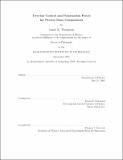| dc.contributor.advisor | David E. Pritchard. | en_US |
| dc.contributor.author | Thompson, James K. (James Karl), 1972- | en_US |
| dc.contributor.other | Massachusetts Institute of Technology. Dept. of Physics. | en_US |
| dc.date.accessioned | 2005-05-19T15:38:49Z | |
| dc.date.available | 2005-05-19T15:38:49Z | |
| dc.date.copyright | 2003 | en_US |
| dc.date.issued | 2003 | en_US |
| dc.identifier.uri | http://hdl.handle.net/1721.1/17011 | |
| dc.description | Thesis (Ph. D.)--Massachusetts Institute of Technology, Dept. of Physics, 2003. | en_US |
| dc.description | Includes bibliographical references (leaves 195-199). | en_US |
| dc.description | This electronic version was submitted by the student author. The certified thesis is available in the Institute Archives and Special Collections. | en_US |
| dc.description.abstract | We have improved the ability to compare the masses of single ions by an order of magnitude to a fractional accuracy of [approx.] 7 x 10-12. This is done by simultaneously confining two ions in a Penning trap, and simultaneously comparing their cyclotron frequencies which are inversely proportional to the masses. The precision of the previous technique of alternately trapping the two ions was completely limited by magnetic field noise. Our new technique reduces the impact of both magnetic field and trap voltage noise by more than three orders of magnitude. We can measure and control the relative motion of the two ions in the Penning trap. We have developed a new mode coupling technique to park the ions on a shared magnetron orbit of diameter 1 mm but on opposite sides of the trap. We superpose on top of this magnetron motion the small cyclotron orbits of 150 [mu] diameter needed to simultaneously compare the cyclotron frequencies. The Coulomb interaction keeps the separation of the cyclotron guiding centers constant, thus minimizing cyclotron frequency perturbations due to ion-ion interactions. The ions spatially average magnetic field inhomogeneities and electrostatic imperfections at the magnetron frequency of 5 kHz. We have developed techniques to precisely measure and systematically vary the ion-ion separation. The control techniques are critical for exploring systematic errors. | en_US |
| dc.description.abstract | (cont.) We discovered that we are sensitive to induced charge distributions within our molecular ions. As an ion moves on its cyclotron motion, it experiences a motional electric field which can polarize the ion. The induced charge distribution then leads to a systematic cyclotron frequency shift. Since the polarizability of the ion depends on its quantum state, we can monitor the quantum rotational state of a single CO+ molecule by measuring its cyclotron frequency. From the size of the observed cyclotron frequency shifts between rotational states, we determine the electric dipole moment of the CO+ to be 1.025(15) eao. This novel example of a polarization force has not been observed previously. | en_US |
| dc.description.statementofresponsibility | by James K. Thompson. | en_US |
| dc.format.extent | 199 leaves | en_US |
| dc.format.extent | 2984854 bytes | |
| dc.format.extent | 3032070 bytes | |
| dc.format.mimetype | application/pdf | |
| dc.format.mimetype | application/pdf | |
| dc.language.iso | eng | en_US |
| dc.publisher | Massachusetts Institute of Technology | en_US |
| dc.rights | M.I.T. theses are protected by copyright. They may be viewed from this source for any purpose, but reproduction or distribution in any format is prohibited without written permission. See provided URL for inquiries about permission. | en_US |
| dc.rights.uri | http://dspace.mit.edu/handle/1721.1/7582 | |
| dc.subject | Physics. | en_US |
| dc.title | Two-ion control and polarization forces for precise mass comparisons | en_US |
| dc.type | Thesis | en_US |
| dc.description.degree | Ph.D. | en_US |
| dc.contributor.department | Massachusetts Institute of Technology. Department of Physics | |
| dc.identifier.oclc | 54454849 | en_US |
